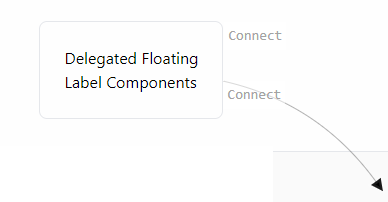@douganderson444/svelte-plumb v0.1.5
Svelte Plumb
Connect HTML Elements with SVG paths. Aiming for a simple API.
- Simple API
- Defaults + Customization
- Connect Elements and EndPoints
- Touch/Mobile friendly
- Restrictive options for connectables (start only, drop only)
- Delegate connectable to a label, which follows the path arrow after connect
- Works with pan, zoom, and scroll (https://www.npmjs.com/package/@douganderson444/panzoom-node)

The Problem
Most javascript diagram libraries use SVGs for non-line / connectors. This is silly, we have HTML for that. This library explores making js diagramming a bit more simple to program and use as a library.
Also, frameworks like js-plumb are a bit complex to use, the setup is a bit much so this is an attempt to simplify it using Svelte's API.
Solution: One Parent Component + One Action directive
The bare minimum is a framework Component wrapper (in this case, Svelte) because:
- SVG lines need to be drawn relative to common, fixed coords (ie. the Parent)
- We need a Parent component to be able to use helper components (like the "Connecting..." HTML div, which is also written in Svelte). Without a Parent component (for instance, if you chose to use action directives exclusively), you wouldn't be able to use Svelte's slick API, and life would be hard.
- In order to have
position: absoluteSVGs, we need a Parent to bepositioned: relative. Need a parent component for this too... if it didn't exist, well, you'd have to make an HTML version of it. So why not use the component framework and kee life simply and easy.
QED, as my high school math teacher would say.
API
HTML elements need an id, if they don't have one, a random one will be generated for them. This is used to connect the elements using element.getElementById().
Basic Use
import {Canvas} from '@douganderson444/svelte-plumb';
<Canvas bind:data let:connectable>
<div use:connectable>This HTMLElement is now connectable for drag and drop</div>
</Canvas>;Use with optional EndPoints
import {(Canvas, EndPoint)} from '@douganderson444/svelte-plumb';
<Canvas bind:data let:connectable>
<div use:connectable={options}>This HTMLElement is now connectable for drag and drop</div>
<!-- OPTION: use end points, absolutely positioned against a relative positioned parent -->
<div class="relative" style="position: relative">
We also add endpoints outside the element.
<EndPoint position={'right'} {connectable} />
<EndPoint position={'left'} {connectable} />
</div>
</Canvas>Use with optional styling
import {(Canvas, EndPoint)} from '@douganderson444/svelte-plumb';
<Canvas bind:data let:connectable on:connected={handleConnected}>
<div use:connectable>This HTMLElement is now connectable for drag and drop</div>
<!-- OPTIONS -->
<!-- Styles are Tailwindcss shortcuts, but regular css works too -->
<!-- OPTION, style your endpoint -->
<div class="relative" style="position: relative">
I like my endpoints like I like my donuts.
<EndPoint position={'left'} {connectable} {options}>
<div
class="h-4 w-4 bg-white rounded-full border-4 border-black hover:ring hover:ring-green-800"
/>
</EndPoint>
</div>
<!-- OPTION, override connecting marker, with slot="marker" -->
<div
slot="marker"
class="h-16 w-16 p-8 rounded-full bg-pink-500 shadow-xl opacity-50 select-none border-[2em]"
/>
</Canvas>So, anything within the Canvas component with a use:connectable action directive will be connectable. The SVG lines will be drawn relative to the Canvas component, and away you go. Everything else is done behind the scenes by Svelte.
Use with optional data
You can also pass data to the on:connected event by setting options on the use:connected={option} directive.
<script>
import { Canvas } from '@douganderson444/svelte-plumb';
function handleConnected(e) {
console.log(e.detail.source?.dataset?.point + ' to ' + e.detail.target?.dataset?.point); // A to B
}
</script>
<Canvas bind:data let:connectable on:connected={e=>console.log()}>
<div use:connectable{{ dataset: { point: 'A' }, restrictions: { startOnly: true } }}>Point A</div>
<div use:connectable{{ dataset: { point: 'B' }, restrictions: { dropOnly: true } }}>Point B</div>
</Canvas>;Use with Optional Delegated Connect Component

You can make a component connectable by wrapping it in the Delegate component. This is useful if you want to make a label connectable, but don't want to make the whole component connectable.
First, make the component by wrapping it in the Delegate componentwith the mounted prop and the on:ready event listener, which is used internally by the svelte-plumb action directive.
<!-- Set accessors true -->
<svelte:options accessors={true} />
<script>
import { Delegate } from '@douganderson444/svelte-plumb';
export let mounted;
export let as; // angleStart, if you want the position of the component to adjust above or below the component
</script>
<!-- Wrap in Delegate Component, with mounted prop and on:ready listener -->
<Delegate {mounted} {as} on:ready>Connect Me</Delegate>Once your custom delegated component is wrapped, you can use it in the use:connectable directive.
<!-- ./App.svelte -->
<script>
import DemoDelegated from './DemoDelegated.svelte';
</script>
<div use:connectable={{ startPoint: { component: DemoDelegated, show: true } }}>
Has a connect component
</div>All Options
Configure your connectable further with the following options:
options = {
dataset: {
// object you want added to <HTMLElement data-attribute-* >
color: 'blue', // adds data-color="blue"
yourObject: 'any'
},
restrictions: {
// restriction put on source and target abilities and quantities
// defaults are false for all
dropOnly: false, // set true if drop zone only, can't start a connection from here
startOnly: false // set true if start zone only, can't drop a connection to here
}
};Events
When a connection is made, an event is fired which passes along details of the connectable node:
<Canvas bind:data let:connectable={options} on:connected={handleConnected}>
function handleConnected(e){
console.log("Source's color", e.detail.source.dataset.color) // color set in source connectable's options.dataset.color
console.log("Target's color", e.detail.target.dataset.color) // color set in target connectable's options.dataset.color
}REPO Demo
npm run dev
REPL Demo
https://svelte.dev/repl/cf05fb3c64674978a717ce1f861a82c0?version=3.49.0
TODO
- CRUD link paths & text
- Move end points
- Add option: number of connectiosn allowed
- Disable duplicate links
- Better label API
Inspiration
https://demo.jsplumbtoolkit.com/flowchart-builder/
https://github.com/bpmn-io/diagram-js
CSS by https://tailwindcss.com/